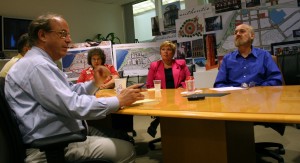By Andrew Firestone
It’s been a long time coming, but after several years of planning, Assembly Square’s development is on schedule to break ground in the second half of 2011, bringing in new residential, professional and recreational features to Somerville.
Now entering the final phases of design, the Federal Realty Investment Trust (FRIT) is clearing its last bureaucratic hurdles to begin construction of the first phase of long-planned square, which will include two new apartment buildings with 400 units between them, a cinema to replace the abandoned one, and a hotel along a brand new Main Street which will house small and medium-sized retail.
“We think that configuration as a first phase works well because we’ll build out the majority of that main street concurrent with the first phase,” said Assembly Square Developer David Walsh. “It provides enough retail frontage on those first three blocks on Main Street that we think we’ve created a destination from the get-go, rather than spreading things out.”
Mystic River Task Force Member Wig Zamore expressed confidence in FRIT’s plans and was pleased with what he called the “rapid” progress of the design phase “It’s a perfect time to build infrastructure when you’re starting to come out of an economic downturn. A lot of people wait too long.”
“All of the national theater companies have expressed strong interest in [developing] as have many national and regional local apartment developers,” said Walsh.
Walsh was happy to report to the Assembly Square Public Advisory Committee that Somerville’s stock has already risen: leading commercial real estate brokerages and national cinema operators are interested in Assembly Square. However, Walsh reports a “generational” shift among the firms.
“The younger guys: Somerville was a hip place where they lived, where their friends lived. The older guys have the old, ‘oh, its assembly square, nothing’s going to happen there, it’s been going on forever’,” said Walsh. “But the older guys are getting over the hump on that.”
Another milestone finally reached is the completion of the designs for the storm-drainage system, which Walsh said will make Assembly Square the “the best, most well-drained portion of Somerville” with the use of a storm-water pipe of six feet in diameter.
Covering the pipe system will be a fishing pier, which will be part of a mixed-use portion of the land devoted to recreation. Built parallel to the river, while crossing a small portion of it, the pier will enable more access to the bluefish and striped bass which are known to reside in those waters.
The chapter 91 licenses of these designs will be the last of the permits necessary before beginning construction.
However, there are still a few unanswered questions. As of yet no developers have expressed interest in the hotel planned next to the phase one buildings. “So far there haven’t been enough interested to know what the timing of hotel development will be,” said Walsh. The Mystic View Task Force also remained adamant that the landscape during the interim between the separate phases not be an eyesore.
Zamore also warned FRIT to not overstep their boundaries in including manufacturing in planned office space for the area, as manufacturing does not generate tax base for those involved. “What we have really been pushing for in Somerville as citizens… is an increase in economic development that really provides a large number of jobs and tax base to the city,” he said. Walsh claimed there was no current plans to introduce manufacturing.
“The most pressing need, to balance the residential density of Somerville, is to get more jobs here so that not so many people will have to leave town to work,” said Zamore.
Currently, permits allow Assembly Square five million square feet of development. If the development is estimated at $300 per square foot this would already be a $1.5 billion project.
Other questions still remain, such as the construction schedule of the new Assembly Square Orange line T-station, as well as the long-delayed construction of IKEA. PAC members were optimistic that the area would be an attractive, accessible center of commerce with construction of the community path the funding of which the city has applied for a national tiger two grant.
“We’re not building a suburban office park there,” said Zamore. “We’re building a district of an urban city.”
















Reader Comments